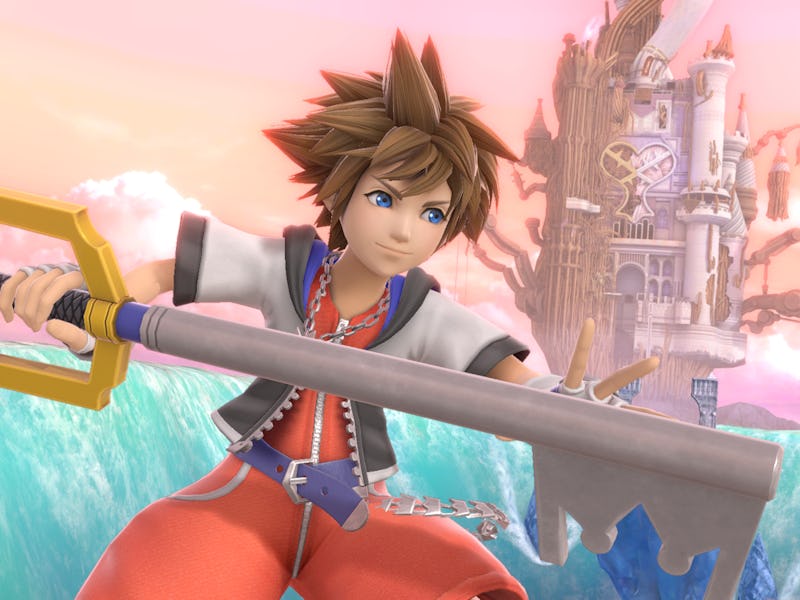Sora is the best ending for Super Smash Bros. Ultimate
The final DLC fighter is also one of the best in one key way.

Super Smash Bros. Ultimate is officially complete, and Sora is the last fighter to join the roster — likely forever. As the top fan-voted character in 2015’s infamous Smash Ballot, how does the iconic Keybalde wielder deliver on all of that hype? Truth be told it’s been a year or two since I’ve touched the game, but this last addition offered the perfect opportunity to bring me back in, both as a casual Smash player and longtime Kingdom Hearts fan.
Is Sora good in Smash Ultimate?
One of the first things I noticed about Sora is that he feels very different compared to most other additions on the standard roster. He’s obscenely light and floaty, which has probably more advantages than drawbacks in casual play. He’s fast enough to zip around any open stages, and his standard jump is so high that you may not even need to use his recovery move till you’re really in danger of being launched.
Here’s an in-depth breakdown of Sora’s moves.
For someone who’s either new to Smash Ultimate or who hasn’t played the game in a while, a fighter like this is a godsend from a movement perspective. When all you need is a standard jump and the occasional dodge to evade most attacks, there aren’t many buttons that need to be pressed for Sora mains to feel mobile. He is quite easy to launch in tight areas with lots of players, but that might only be a problem if you’re playing against more experienced opponents.
This accessible philosophy translates to Sora’s moveset as well, with the character having lots of capable moves that don’t require much precision to pull off. His bread and butter is a three-hit combo, which sends players flying across the stage by mashing B and throwing the control stick in any direction. While many of the basic combo arcs will likely be memorized by hardcore players fairly quickly, they’re especially effective in casual play or against AI opponents. Fans of the series will love watching Sora dash across stages using his trademark weapon, and luckily the sheer effectiveness of this base attack offers plenty of opportunities to observe.
Sora’s three-hit combos are easy to perform and very effective.
If you’re standing still you’ll activate Sora’s unique neutral special, which is a three-pronged cycle of Magic between Firaga, Thundara, and Blizzaga in that order. I’ve personally found Firaga to be the most effective of the three as you can keep spitting out fireballs until you get hit. The sustained attack is supremely effective in certain situations.
If you’re playing in a more crowded field, though, Thundaga can clear the slate really quickly. I wish there was a way to actually select the spell you wanted to use like Sora can do in his source franchise, but I imagine Sakurai’s team felt that flexibility might be too overpowered.
Firaga is great for sustained damage.
When casual players fight as Sora, they’ll probably cycle between mashing special directionals while using the standard A attacks to keep some distance from foes. Because he’s so fast, Sora’s dash+A is really powerful, and his up+A is a strong way to chip in a chunk of damage as long as your opponent gets caught in it. The general path to success with Sora is using A to set up a combo and then going in for the kill with a flurry of specials. That might sound challenging in text, but it’s a digestible cycle in practice.
What about Sora’s stages, Spirits, and other fan service?
Every character in Super Smash Bros. Ultimate has been handled with the utmost care and fan service, and, without spoiling things too much for diehard Kingdom Hearts enthusiasts, Sora is no exception. His Classic Mode is made up almost entirely of Stamina Battles designed to mimic the HP-based combat of the source series, and you’ll wage war with creatively designed facsimiles of various Heartless, Xehanort, Organization XIII, and more. You’ll likely get the references if you’ve played through the numbered series entries, but they’ll be fairly ordinary battles for everyone else.
This isn’t Destiny Islands, but it’s close enough.
Of particular note, I would remind fans not to ignore Sora’s DLC Spirit Board, which is easy to miss in the cluster of menus. The Aqua fight in particular was a moment that offered me all the feels I needed to feel rewarded for my purchase.
The stages and music are perhaps the weakest part of the bundle, simply because there’s not much to say about them. Hollow Bastion is basically a Final Destination clone with a Kingdom Hearts aesthetic, and the music tracks, while a nice selection, are the exact same versions fans have heard many times over the last decade. Most of the songs fit in Smash Ultimate just fine, but it would’ve been way more fun to hear bespoke orchestrations of them.
Despite its transformations, Hollow Bastion is a boring stage.
Super Smash Bros. Ultimate has benefited greatly from its DLC roster, but it’s no secret that many of its post-launch fighters featured special mechanics that got a bit too in the weeds to bring lapsed players back.
While the preceding Kazuya Mashima might be one of the most complex characters Smash has ever seen, Sora acts as the perfect end to the Fighters Passes because his moves are simple and clean. His streamlined command list is a great reminder that this series is at its best when everyone can get in on the action regardless of skill level. Especially if you love Kingdom Hearts, this is an awesome package to get you back into the game.